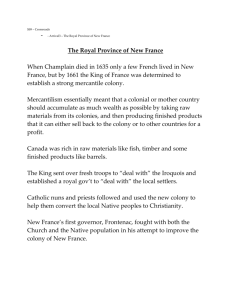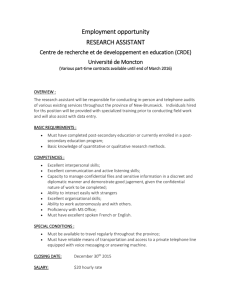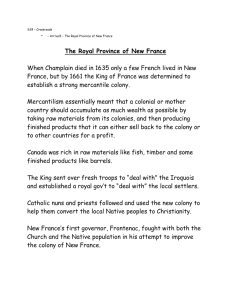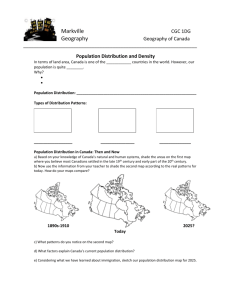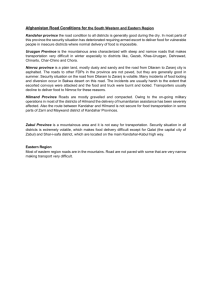NB.6.RoadtoRebellion.doc - Early Canada Historical Narratives
advertisement
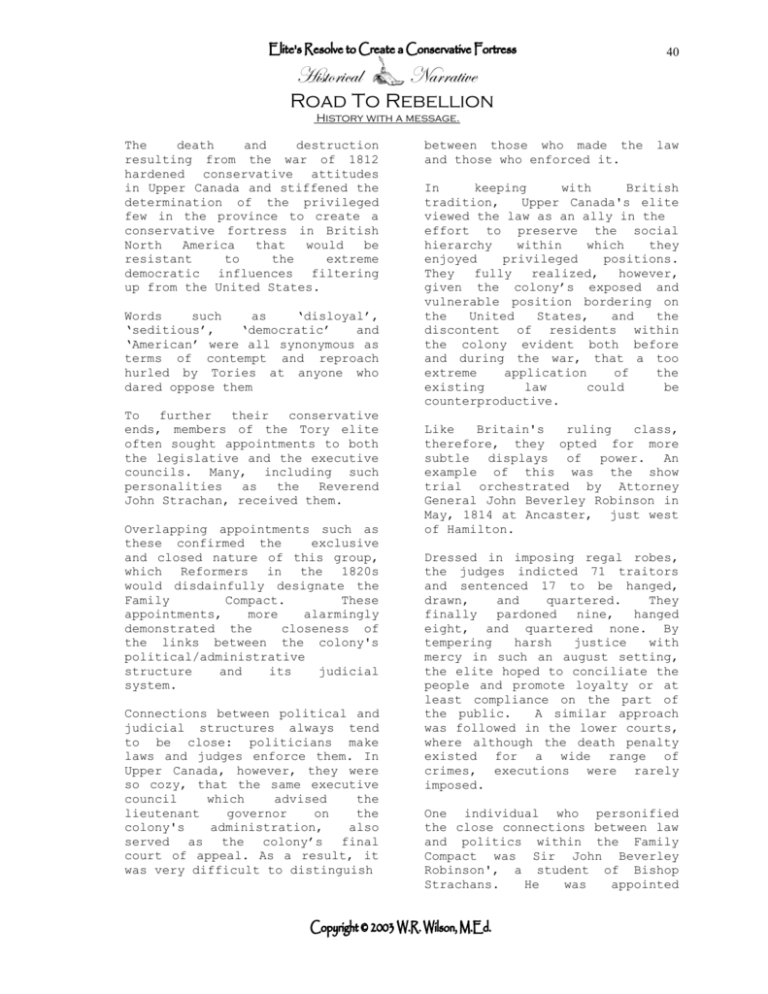
40 Historical Narrative Road To Rebellion History with a message. The death and destruction resulting from the war of 1812 hardened conservative attitudes in Upper Canada and stiffened the determination of the privileged few in the province to create a conservative fortress in British North America that would be resistant to the extreme democratic influences filtering up from the United States. Words such as ‘disloyal’, ‘seditious’, ‘democratic’ and ‘American’ were all synonymous as terms of contempt and reproach hurled by Tories at anyone who dared oppose them To further their conservative ends, members of the Tory elite often sought appointments to both the legislative and the executive councils. Many, including such personalities as the Reverend John Strachan, received them. Overlapping appointments such as these confirmed the exclusive and closed nature of this group, which Reformers in the 1820s would disdainfully designate the Family Compact. These appointments, more alarmingly demonstrated the closeness of the links between the colony's political/administrative structure and its judicial system. Connections between political and judicial structures always tend to be close: politicians make laws and judges enforce them. In Upper Canada, however, they were so cozy, that the same executive council which advised the lieutenant governor on the colony's administration, also served as the colony’s final court of appeal. As a result, it was very difficult to distinguish between those who made the and those who enforced it. law In keeping with British tradition, Upper Canada's elite viewed the law as an ally in the effort to preserve the social hierarchy within which they enjoyed privileged positions. They fully realized, however, given the colony’s exposed and vulnerable position bordering on the United States, and the discontent of residents within the colony evident both before and during the war, that a too extreme application of the existing law could be counterproductive. Like Britain's ruling class, therefore, they opted for more subtle displays of power. An example of this was the show trial orchestrated by Attorney General John Beverley Robinson in May, 1814 at Ancaster, just west of Hamilton. Dressed in imposing regal robes, the judges indicted 71 traitors and sentenced 17 to be hanged, drawn, and quartered. They finally pardoned nine, hanged eight, and quartered none. By tempering harsh justice with mercy in such an august setting, the elite hoped to conciliate the people and promote loyalty or at least compliance on the part of the public. A similar approach was followed in the lower courts, where although the death penalty existed for a wide range of crimes, executions were rarely imposed. One individual who personified the close connections between law and politics within the Family Compact was Sir John Beverley Robinson', a student of Bishop Strachans. He was appointed 41 acting attorney general at the age of 21 before he had even been called to the bar. In 1818 he became attorney general and in 1820 he joined the legislative assembly, where he became the primary spokesman for the province’s elite. In 1829 Robinson was appointed chief justice, a position he held until 1863. In addition to the courts, the church was also used to manipulate and control the population. The Constitutional Act had established the Church of England as the state church with all the majesty that entailed. The government looked to the church to monitor and manage the behaviour of the people, and to assist it to do so, the church was assigned control of educational policy and funded by monies from the sale of the Clergy Reserves. Majesty and mercy eventually proved inadequate to disguise the fundamentally self-centered nature of the elite’s agenda. In the 1820s as political, administrative and judicial decisions became increasingly more domineering and oppressive, some assembly members by the end of the decade joined together as ‘His Majesty’s faithful opposition,’ a term then being used in the British Parliament. Several issues promoted the development of a Reform movement. In 1817 Upper Canadians, who were born in the United States after 1783, were stripped of their rights to vote and to own land. At the instigation of John Beverley Robinson, one Americanborn resident, who was elected to the assembly, was denied the right to take his seat. This legislation, known as the Alien Question, was blatantly this discriminatory and it caused public resentment developed into anger. When those who protested this intolerance received no satisfaction from their appeals to the lieutenant governor, they petitioned directly to the British government, a tactic bitterly opposed by the elites, because it undercut their authority. Their annoyance turned to outrage when the Colonial Secretary ordered that Americanborn Upper Canadians be granted equal civil rights. A series of other ‘outrages’ increased the fury of the Family Compact. A fiery Scots reformer named Robert Gourlay, had come to Upper Canada in 1817 with the intention of settling and had almost at once fallen afoul of those in control of the colony. He began to make inquiries into the administration of the province, to collect statistics and to send out questionnaires, convassing the citizens for their grievances. He encouraged them to speak out for change, virtually inviting them to criticize the government. When a leading member of the Family Compact, the Reverend John Strachan, attempted to silence him, Gourlay called him “a monstrous little fool of a parson” and organized a public convention to discuss the colony’s problems. At this point the elite removed the velvet glove, exposed the mailed fist and abandoned any pretence of leniency and mercy. A ban was placed on all public conventions and supporters of Gourlay were dismissed from their places of employment. Gourlay was ordered to leave the province. When he refused, he was charged with sedition sentenced to eighteen months in jail. Gourlay served his sentence in the Niagara jail, mostly in a 42 small room with the window nailed shut, paper and pencil forbidden to him. During this period his mental health deteriorated greatly. Few recognized the wizened man who finally appeared before them 8 months later in the hot, uncomfortably crowded courtroom. His clothes made to fit a portly person hung on a stooping skeleton. His once red face was grey, his hands shook visibly, his eyes wondered vacantly about the courtroom Despite his wretched condition, he was found guilty and ordered to leave the province within twenty-four hours or face death. He first returned to England then became an obscure settler in the United States. His unjust sentence created widespread indignation among all rightthinking people. His name and case were not forgotten. Authoritarian repression culminated in the case of Judge John Walpole Willis, who arrived from England as a junior judge in 1827. Far from supporting the political shenanigans of the Family Compact, Willis questioned what was going on. He argued that loyalty was not God-given, but had to be earned. “Statues have not given the People their Liberties; their Liberties have produced them.” The Tories were infuriated by his fairness and sought his immediate dismissal. Although the Reformers swept the 1828 election, they failed to work together. They lacked unity since political parties in the modern sense had yet to emerge. Violence simmered in the 1820s and came to a boil in the 1830s. Of the 51 riots recorded in Upper Canada before 1840, 44 of them took place during the 1830s. In 1842 the Assembly of Upper Canada declared Gourlay’s arrest to be “unjust and illegal” and his sentence “null and void.” He was offered a pension. The Tories worked to bolster their political position, but increasingly their behaviour and integrity were being questioned. As a result they became more belligerent in their efforts to put a stop to the rising Reform movement. In what is known as the Types Riot, young sons of the elite destroyed the press of William Lyon Mackenzie and threw it into the lake. Sheet-covered men in blackface stripped, tarred and feathered a long-time Reformer. Those responsible for this illegal act included two magistrates, one of whom was also the local sheriff! Bully-boy tactics were used to disrupt political meetings. The , as well as effigy burning and personal assaults. Moderate Reform leaders like William Baldwin and his son, Robert, argued that “every free Government must have governing party and a two parties, a party in check.” For the Family Compact this was utter nonsense. There were only loyal Tories or disloyal Reformers. The privileged few were seemingly impervious to prosecution for committing these fragrantly illegal activities, since no one was brought before the courts. The law, far from being above politics, was its handmaiden. In spite of all the grief and grievances suffered and endured by the Reformers, those who advocated rebellion were always few in number. Most moderate Reformers were British subjects who distrusted extreme views and feared disloyalty. They saw little to be gained by physically confronting the established authority with its military might. Tragically, at this critical period in the life of the little colony, the most incapable of 43 governors, Sir Francis Bond Head, was selected by the British cabinet to promote conciliation in Upper Canada. For his inexperience the Cabinet which appointed him was responsible. For his incompetence and ignorance, Head was solely to blame. Sir Francis Bond Head did not know the meaning of collaboration. He lacked common sense, modesty and discipline and combined insults to his subjects with disobedience to his superiors. His bone-headedness brought the crisis to a climax. In the violent and crooked election of 1836, Head stomped the province, and by using bribes, threats, violence and fear-mongering, he led the Tories to an overwhelming victory. All moderates like Robert Baldwin were shut out of office and in disgust and despair, these moderate Reformers decided to withdraw from politics. In so doing they left leadership in the hands of the more radically inclined. These inflammable elements lost all patience with the process, and burst forth into insurrection. Mackenzie, a radical Reformer, was essentially an agitator. When he decided that reform in government was not possible to achieve peacefully, he unreservedly urged incitement to rebellion. It was said of Mackenzie that “he felt a longing desire to right the wrongs which he saw everywhere around.” This, therefore, constituted “his mission as a public man in Canada.” At heart Mackenzie’s fundamental political tenant was that government was a trust to be administered on behalf of the governed. Any deviation by a public person from the straight and narrow path of public service, any abuse of public office for private advantage and high salary, any undue private gain from public measures must be denounced and exposed for the public good. The central theme was of government as a trust. In Upper Canada he believed that trust had been violated again and again and now, anything less than the complete overthrow of the system would be a waste of time. “To die fighting for freedom is truly glorious,” he wrote in November 1837. “Who would live and die a slave? Come if you dare! Here goes!” Mackenzie stormed about the province preaching revolution among the disaffected. In His Own Words “Canadians, Do you love freedom? I know you do. Do you hate oppression? Who dare deny it? Do you wish perpetual peace and a government bound to enforce the law to do to each other as you would be done by? Then buckle on your armour, and put down the villains who oppress and enslave your country. One short hour will deliver our land from the oppressor. He who commands the winds and the waves will be with us. Up then brave Canadians. Ready your rifles and make short work of it.” The Little Rebel’s plan was to seize the city and declare the independence of the province. In December 1837, he donned several overcoats to shield him from the cold and the .15 calibre bullets and led roughly one thousand illarmed men on a pathetically planned, totally unsuccessful assault on Toronto. Pursued by the Loyal militia and warriors from the Six Nations, the rebels frantically dispersed in all directions. Mackenzie, a 44 Review: Road to Rebellion one thousand pound price head, was protected by the of the province as he fled frontier and crossed to into the United States. on his people to the safety Mackenzie had completely misunderstood the sentiment of the citizens of Upper Canada and falsely exaggerated the degree of support they would give to his seditious movement. However, the fact that the rebellion fizzled and its perpetrators fled did not mean that dissatisfaction and dissent were not widespread in the province. Many Upper Canadians sympathized with the misguided malcontents and were quite prepared to see their punishment tempered by mercy. When some 800 alleged rebels were caught and held for what were expected to be fast and fearsome trials, petitions for clemency totalling more than 30,000 signatures flooded into Toronto. Into this tense and turbulent mixture, the British government belatedly acted in a frantic attempt to repair the fractured Canadian political system. Enter the emissary charged with resolving the Canadian conflicts: John George Lambton, the Earl of Durham. Review Vocabulary: elite, tradition, ally, hierarchy, vulnerable, synonymous, reproach, counterproductive, opted, orchestrated, overlapping, exclusive, judicial, disdainfully, quartered, august, compliance, imposed, personified, petitioned, undercut, grievances, sedition, instigation, blatantly, discriminatory, authoritarian, culminated, shenanigans, impervious, infuriated, integrity, perpetrators, tempered, alleged, insurrection, incitement, disaffected, belatedly, conciliation, collaboration. Review the following questions before reading the narrative, then answer them after completing it. 1. Why do you think the elite were so agitated by the actions of Robert Gourlay? 2. Do you consider Gourlay a responsible critic or an irresponsible agitator? 3. Explain: (a) hardened conservative attitudes; (b) removed the velvet glove exposing the mailed fist; (c) synonymous as terms of contempt; (d) overlapping appointments (e) the rebellion fizzled; (f) fear mongering; (g) too extreme an application of the law could be counterproductive. 4. What is wrong with individuals having overlapping appointments? 5. Why was Upper Canada considered to be in a ‘vulnerable’ position? 6. What were the extreme democratic principles the elite wanted to keep out of Canada? 45 7. How did the Family Compact endeavour to pacify the people of the province? 8. (a) Why did the leading moderate Reformers retire from the field? 9. (b) Criticize this action. 10. If Bond Head and the Family Compact were so objectionable, why did the people of the province give the Tories an overwhelming majority in the Assembly in the 1836 election? 11. How did people of the province show their understanding if not support for the rebels? 12. Was Mackenzie right or wrong in fomenting the rebellion? 13. What is wrong with having a close connection between those who make the law and those who enforce it? 14. Explain: Fractured Canadian political system. 15. In this instance, what was history’s message? 16. Briefly summarize the main theme and the important details of this narrative.
